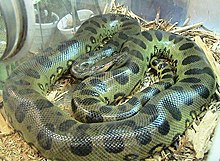genus of snakes From Wikipedia, the free encyclopedia
The Anaconda or green anaconda (Eunectes murinus) is one of the largest snakes in the world.
| Anacondas | |
|---|---|
 | |
| Eunectes murinus | |
| Scientific classification | |
| Kingdom: | |
| Subphylum: | |
| Class: | |
| Order: | |
| Suborder: | |
| Family: | |
| Genus: | |
| Species: | E. murina |
It is a non-venomous boa species from South America. It is the thickest, heaviest, and second longest known living snake (behind the reticulated python). The term "anaconda" usually means this species.
The anaconda is also called the water boa. It lives in swampy areas of tropical South America. The snake spends a lot of time in shallow water. This hides it from unsuspecting prey. Anacondas give birth to live young. Twenty to forty baby snakes are born at one time. The largest specimens measured 17.1 ft (5.2 m) long and weighed 215 lb (98 kg)[1]

All snakes are carnivores (meat-eaters). Anaconda eat 4 to 5 times each year. This is because it takes them 3 to 4 months to digest their food. Anacondas normally hunt at night. Anacondas kill by constricting (squeezing) the prey until it can no longer breathe. They may also drown their prey. Like all snakes, they swallow the prey whole. They swallow it head first. The anaconda's top and bottom jaws are attached to each other with stretchy ligaments/b This lets let the snake swallow animals wider than itself. Snakes do not chew their food. They digest it with strong acids in their stomach. Anacondas eat pigs, deer, caiman (a type of crocodilia), birds, fish, rodents (like the capybara and agouti) and other animals. After eating a large animal, the anaconda does not needs food for a long time/ It will rest for weeks after eating. The young (called neonates) can care for themselves soon after birth. This includes hunting. At this age, they are mostly defenseless against large predators. They eat small rodents (like rats and mice), baby birds, frogs and small fish. All anacondas are very expensive. Their cost is between $5,000 and $10,000, depending on their size and the breeder.[2]
There are four species in the genus Eunectes:
| Species | Taxon author | Subspecies other than nominate [3] |
Common name | Geographic range |
|---|---|---|---|---|
| E. beniensis | Dirksen, 2002[4] | 0 | Bolivian anaconda | South America in the Departments of Beni and Pando in Bolivia. |
| E. deschauenseei | Dunn and Conant, 1936[3] | 0 | Dark-spotted anaconda | South America in northeastern Brazil and coastal French Guiana.[5] |
| E. murinus | (Linnaeus, 1758)[3] | 1 | Green anaconda | South America in countries east of the Andes, including Colombia, Venezuela, the Guianas, Ecuador, Peru, Bolivia, Brazil and on the island of Trinidad.[5] |
| E. notaeus | Cope, 1862[3] | 0 | Yellow anaconda | South America in eastern Bolivia, southern Brazil, Paraguay and northeastern Argentina.[5] |
Seamless Wikipedia browsing. On steroids.
Every time you click a link to Wikipedia, Wiktionary or Wikiquote in your browser's search results, it will show the modern Wikiwand interface.
Wikiwand extension is a five stars, simple, with minimum permission required to keep your browsing private, safe and transparent.